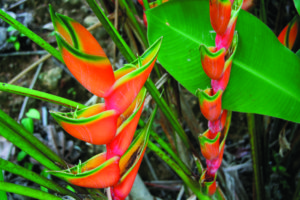
 They don’t say “hello” in Costa Rica, they say Pure Vida (purr-ah veedah) as a greeting. Literally translated it means “pure life,” loosely it translates as “life is good.” Imagine being with a cheery “life is good” ten, twenty, fifty times a day. Pretty soon you internalize it and life IS good!
They don’t say “hello” in Costa Rica, they say Pure Vida (purr-ah veedah) as a greeting. Literally translated it means “pure life,” loosely it translates as “life is good.” Imagine being with a cheery “life is good” ten, twenty, fifty times a day. Pretty soon you internalize it and life IS good!
Costa Rica is another of the Blue Zones on our lovely green-and-blue Earth. Blue Zones are those five areas on our planet where is was discovered that people lived the longest. Last month I told you about the only Blue Zone in the United States, Loma Linda, California. This month I’ll let you know about Costa Rica, the only Blue Zone I’ve actually visited. But it is the one place I’d move to in a heartbeat if all things were equal. But my family and grandkids don’t want to move and I don’t want to leave them. They give me so much happiness.
Costa Ricans live to be ninety year old and older at a rate that is two-and-a-half times greater than US citizens. They have decreased rates of cancer, diabetes, and heart disease, yet they spend one-fifteenth of what we Americans spend on healthcare. How can that be? What are they doing that we should be doing? Pharmacias (drug stores) are on almost every corner in the cities. The pharmacias sell mostly homeopathics for healthcare. Homeopathics are generally considered to be safe, effective, and cheap. And for mental and spiritual well-being there are several churches in each city.
I was in Costa Rica in 1999, after graduating naturopathic medical school, and I consider it the best vacation I ever had. It was an ecological tour with a dedicated guide and instructor. Twelve people travelling together to learn more about the ecology of Costa Rica—why coffee needs to be grown under shade trees, how to avoid being bonked on the head by falling coconuts, and myriad other tidbits of knowledge. We hiked in jungles to see butterflies, orchids, snakes. We swam in rivers, took water tours where our guide could spot Caymen Eyes or a hummingbird nest yards from the boat. Using a machete he’d open a coconut for all to try. We awoke early to the sounds of howler monkeys, ate mostly vegetarian food, and basked in the glow of lava running down mountains.
The food was always freshly prepared, never packaged, as it is a small country and there’s no place for garbage to build up. For the duration of the trip I had the same meal for dinner every night, corvina with hearts of palm salad and every night it was prepared differently though incorporating identical foods. Costa Ricans have a diet that is high in complex carbohydrates, not the simple carbs over-consumed in America. There was an abundance of fresh foods, locally made cheeses, and wonderful seafood. Members of our group were taken to a garden where we each took turns digging and pulling Casavas, a staple food of Costa Rica, much like a large yam. Then we were treated to a meal of them baked, mashed, even as freshly prepared ‘potato’ chips.
Costa Ricans eat a diet high in fruits–bananas (they grew outside the hotel rooms), plantains (which are not sweet), papayas (both green and ripe), and strawberries. Though it was March they already had strawberries, several months away from ripeness in the rainy Northwest. A sweet young woman came onto the bus and we all sampled her basket of berries. But when we purchased baskets of berries from the farmstand we’d stopped at we discovered alas, that we’d been duped. The berries we bought were not sweet like the ones we’d sampled on the bus. Caveat emptor! Buyer beware!
The Costa Ricans who live outside of cities work, hard. They don’t spend their days sitting in front of computers or in cars or watching TV. They grind their own corn for their daily tortillas, manually (or more likely fe-manually). Everyone in the country has a garden, for grocery stores are few and far between. Beans, corn, and squash are grown in every garden and beans are eaten daily. Many grow their own coffee in the shade of the jungle and daily use machetes to keep that jungle at bay.
Thus the average Costa Rican earns time for fishing, socializing, or just loafing. There are a lot of hammocks to be enjoyed in the mild climate of Costa Rica. On a video of that trip in a view of me resting in one of those hammocks with a book fallen across my face, saying, “All I have to do is breathe in and breathe out.” Any wonder I’d like to move there?
The Nicoya Penninsula of Costa Rica has been cut-off from rampant development for several decades. Most roads in the outlying areas are dirt or gravel, becoming mud roads during the rainy season. And it rains a lot in jungles. One person in our group complained when our bus was delayed for a few hours, waiting for torrential rains to abate so we could continue our travels. I thought back to the dirt and gravel roads of outlying China that I’d travelled in 1996. Better roads would make Costa Rica more travelled, which would completely change the character of this gorgeous Blue Zone country. No wonder so many live so long there.
No Comments
Leave a comment Cancel